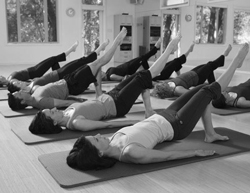Through emphasizing proper breathing technique, correct pelvic and spinal alignment, along with concentration on fluid and smooth flowing movement, anybody can become become deeply in tune with their body. You can even learn how to manipulate and control its movement.
In the practice of Pilates, it is the quality of movement which is valued over the quantity of repetitions. According to the Mayo Health Clinic, it is important to remember that proper breathing is essential, and helps you execute movements with maximum power and efficiency. Lastly, learning to breathe properly can also reduce stress.
According to Pilates.com, Pilates exercises help develop a strong “core,” or center of the body. The core consists of the deepest abdominal muscles along with the muscles that are closest to the spine. Control of the core is accomplished by integrating the trunk, pelvis and shoulder girdle.
Pilates strives to elongate and strengthen, thus improving muscle elasticity along with joint mobility. A body which is balanced with strength and flexibility is less likely to be injured. Pilates conditions the whole body, even the feet and ankles, according to Pilates.com. No muscle group is over worked or under worked. Your entire musculature is evenly conditioned and balanced, helping you enjoy daily activities and sports with improved ease, better performance and less chance of injury. That is why so many sports teams and elite athletes now use Pilates as an integral part of their training regimen.
Many of the exercises are performed in reclining or sitting positions, and most are low impact and partially weight bearing.
You should consult with your medical professional if you experience any doubts about your Pilates program, according to Pilates.com. If you suffer from physical pain, you should take extra care before beginning a Pilates program.
According to Pilates.com, You should never feel pain while practicing Pilates. If you do, you know that there is something wrong. Don’t be afraid to pull back if you feel overwhelmed. Pilates was designed to progress naturally from one movement to another. If you feel stopped at one movement, don’t give up. Start at the beginning and work your way back to the areas you have found most challenging.
According to Pilates.com, Pilates was developed in the early 20th century by Joseph Pilates. He first called Pilates “contrology” because he believed that the mind controlled the muscles. There are six original principles of Pilates which are: concentration, control, center, flow, precision and breathing.
Many Pilates teachers refer to the group of muscles in the center of the body – which encompasses the abdomen, lower and upper back, hips, buttocks and inner thighs, the “powerhouse.” All movement in Pilates should begin from the powerhouse and flow outward to the limbs.
Chris Hirschler, Ph.D., MCHES, Assistant Professor of Health Studies, School of Nursing & Health Studies, says “Anyone who has practiced Pilates knows it’s great for one’s core muscles. My ideal week consists of Yoga, Pilates, free weights and Zumba.”
Professor Julie Schaaff, Lecturer in the School of Nursing & Health Studies, M.S. in Exercise Physiology, believes mind-body exercises like Pilates and Yoga have numerous physical and emotional benefits as well. “Pilates contributes to improved coordination, posture and balance, enhanced flexibility and posture and can also reduce pain-especially within the lower back.”
Pilates is great for stress relief. It can reduce stress by concentrating on breathing techniques and movement which help you to stay focused. Breathing is one of the most important aspects of Pilates. “Breathing through a challenging pose helps us to learn to stay calm in other stressful situations,” explains Schaaff.
It’s true, a deep breath that begins down in the diaphragm can impact significantly on stress and should therefore be used in any stressful situation. Actually taking the time to stop and inhale/exhale deeply gives the body and mind a brief moment of self-awareness. Too often students become so caught up in a task that we forget to experience time in the present moment. Recognizing how busy we are, and correcting it with a prolonged breath, is a positive response that will balance stress levels. Pilates can teach you how to breathe correctly and is known as “diaphragmatic breathing,” according to Pilates.com.
Mind and body exercises remind us to pay attention to what we are feeling inside of our body- our breathing, thoughts and feelings, so that we can learn to develop contentment which in turn can lead to living a more fulfilling stress free way of life.
According to US News, Pilates techniques will help you achieve an overall mindfulness and attention to the here and now. Being in complete control of your movement will mean that you’ll enhance your quality of life and ultimately reduce stress.
Instead of performing exercises in autopilot, you’ll be mindful of every action that is being carried out within your body and a state of complete awareness can be achieved. Once your Pilates class is over, you’ll be left with a sensation of calm and feel completely energized.
The best part is that Pilates is easy to start. There is a plethora of books, tutorials and videos to help get you started. On campus, students can check out the Yoga Club and even register for a 1.0 credit Physical Education Yoga, Pilates, or Tai Chi class. What can be better than earning credits while making an effort to become healthier?
If you practice Pilates regularly, it will change your body. According to the Weill Cornell Medical College, “Pilates is known for creating long, strong muscles and a leaner look; Pilates improves muscle tone, balances musculature, supports beautiful posture, and teaches you to move with ease and grace.” All of these aspects will make you look and feel fit.
Making the choice to engage in a physical education class such as Pilates is an enormous stress reliever and can also boost self-esteem. When you feel better, that radiates, and you look better as a result.
PHOTO COURTESY of bodyinbalancephysicaltherapy.com




